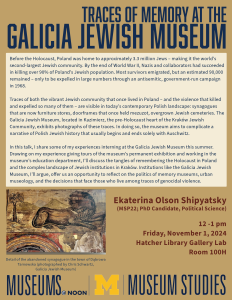
Presentation by Ekaterina Olson Shipyatsky, PhD Candidate in Political Science (Political Theory) and the Museum Studies Certificate Program.
Before the Holocaust, Poland was home to approximately 3.3 million Jews – making it the world’s second-largest Jewish community. By the end of World War II, Nazis and collaborators had succeeded in killing over 90% of Poland’s Jewish population, about three million people. Most survivors emigrated, but an estimated 90,000 remained – only to be expelled in large numbers through an antisemitic, government-run campaign in 1968.
Traces of both the vibrant Jewish community that once lived in Poland – and the violence that killed and expelled so many of them – are visible in today’s contemporary Polish landscape: synagogues that are now furniture stores, doorframes that once held mezuzot, overgrown Jewish cemeteries. The Galicia Jewish Museum, located in Kazimierz, the pre-Holocaust heart of the Kraków Jewish Community, exhibits photographs of these traces. In doing so, the museum aims to complicate a narrative of Polish Jewish history that usually begins and ends solely with Auschwitz.
In this talk, I share some of my experiences interning at the Galicia Jewish Museum this summer. Drawing on my experience giving tours of the museum’s permanent exhibition and working in the museum’s education department, I’ll discuss the tangles of remembering the Holocaust in Poland and the complex landscape of Jewish institutions in Kraków. Institutions like the Galicia Jewish Museum, I’ll argue, offer us an opportunity to reflect on the politics of memory museums, urban museology, and the decisions that face those who live among traces of genocidal violence.
Before the Holocaust, Poland was home to approximately 3.3 million Jews – making it the world’s second-largest Jewish community. By the end of World War II, Nazis and collaborators had succeeded in killing over 90% of Poland’s Jewish population, about three million people. Most survivors emigrated, but an estimated 90,000 remained – only to be expelled in large numbers through an antisemitic, government-run campaign in 1968.
Traces of both the vibrant Jewish community that once lived in Poland – and the violence that killed and expelled so many of them – are visible in today’s contemporary Polish landscape: synagogues that are now furniture stores, doorframes that once held mezuzot, overgrown Jewish cemeteries. The Galicia Jewish Museum, located in Kazimierz, the pre-Holocaust heart of the Kraków Jewish Community, exhibits photographs of these traces. In doing so, the museum aims to complicate a narrative of Polish Jewish history that usually begins and ends solely with Auschwitz.
In this talk, I share some of my experiences interning at the Galicia Jewish Museum this summer. Drawing on my experience giving tours of the museum’s permanent exhibition and working in the museum’s education department, I’ll discuss the tangles of remembering the Holocaust in Poland and the complex landscape of Jewish institutions in Kraków. Institutions like the Galicia Jewish Museum, I’ll argue, offer us an opportunity to reflect on the politics of memory museums, urban museology, and the decisions that face those who live among traces of genocidal violence.